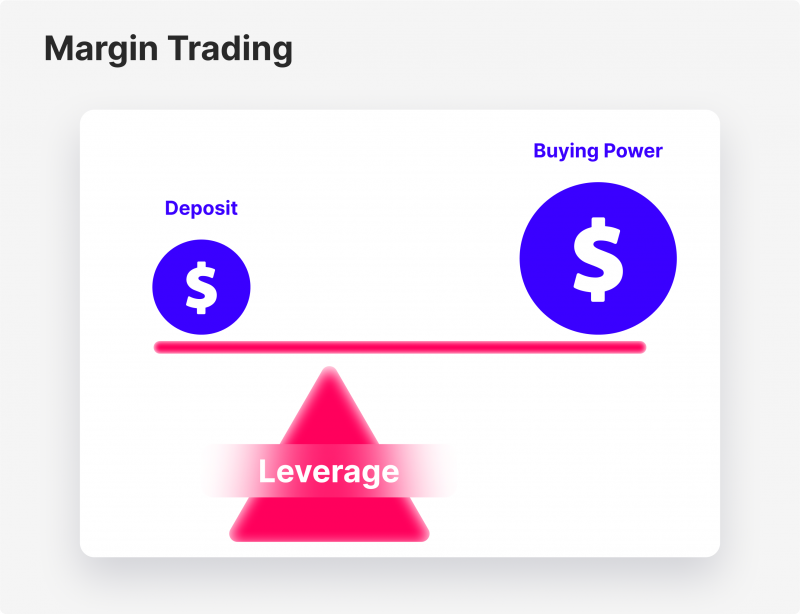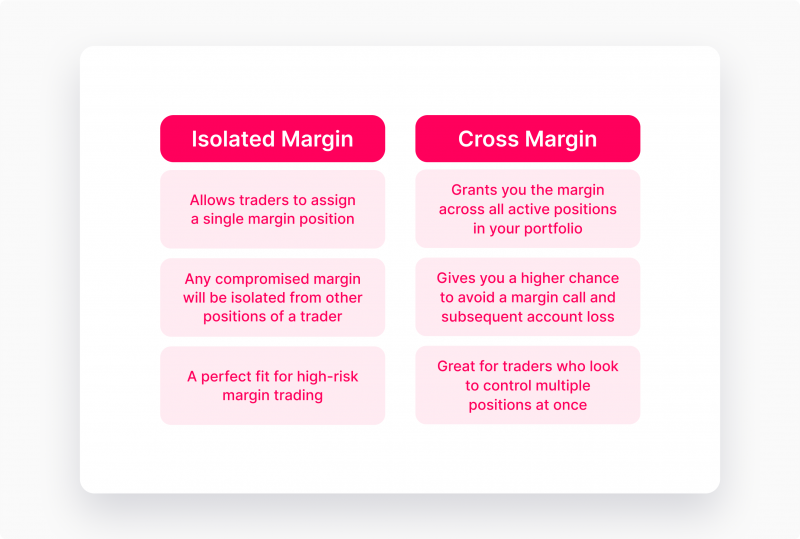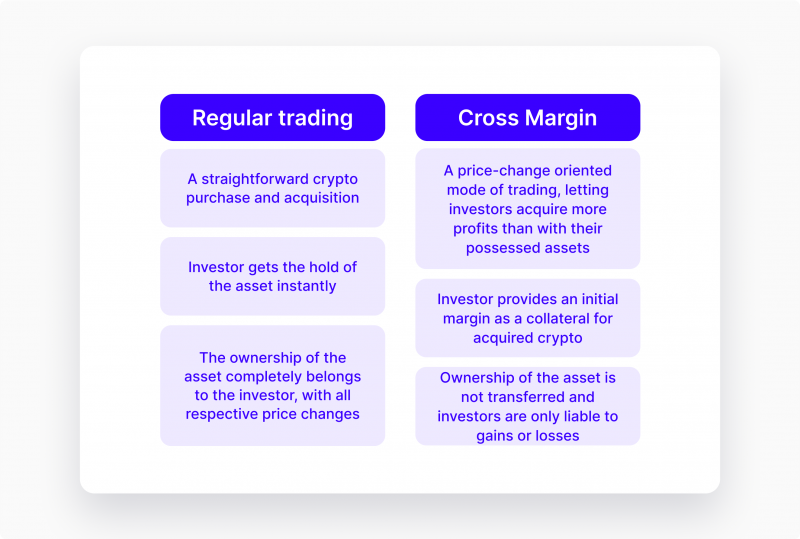Cross Margin vs Isolated Margin: What’s the Difference?

Cross margins and isolated margins represent two sides of the margin trading coin. These two mechanisms accommodate significantly different options, accommodating traders with wildly varying strategies. While both cross and isolated margins present opportunities for lucrative profits, it is essential to understand the difference.
In margin trading, both cross and isolated margins offer the opportunity to borrow a certain amount of Cryptocurrency from a given exchange platform with the intention to benefit from a price change. In both cases, you also need an initial collateral to make the deal.
However, the difference here is that with isolated margins, you can receive the temporary crypto liquidity by only putting a collateral on a single margin position. With cross margins, your entire margin portfolio is considered as a margin position.
Before we dive deeper into the differences between cross and isolated margins, let us start from the beginning:
Margin Trading Defined
Imagine entering a crypto trading landscape with only a few dollars to facilitate your efforts. Even if you have a lot of practical trading experience and a good understanding of crypto, your investment will likely yield minuscule results. After all, even a 200% yield on 50 dollars is only 100 dollars. So, if you have the experience and the knowledge but no funds to invest, the doors of crypto are locked away from you, right? Not exactly.
That is where margin trading comes in to facilitate your investing success. So, what is exactly?
Margin trading is a process of acquiring a position on higher volumes of crypto that is permitted from your cash funds.
With this methodology, you can effectively borrow the desired crypto volumes, reach your desired goals and then return the borrowed funds. You can acquire various leveraged positions, letting you multiply the number of cryptos purchased. In this context, the margin is the required funds to reach a leveraged position. While you can borrow significant amounts of crypto with margin trading, there’s a certain limit.
Key Takeaways
- Margin trading allows you to benefit from your correct price anticipations on the crypto market.
- With margin trading, you can effectively borrow the trading funds from an exchange platform and keep all the price change gains for yourself. However, if the price goes in the opposite direction, you suffer all respective losses.
How Does Margin Trading Work?
The margin trading concept was designed to assist in pursuing scaled opportunities and to reward the traders for their sage market knowledge. With this mechanism, it is possible to reap significant rewards with limited funds. But be warned that this effective sword cuts both ways and involves considerable risks.
To truly understand the ins and outs of margin trading, we need to examine several terms and processes involved:
Initial Margin and Maintenance Margin
The initial margin is the minimum amount required to execute your requested position. In simple terms, if you wish to acquire a bitcoin of $ 5,000 value, you must have a certain amount of money in your account. The proportion of initial margin requirements varies depending on the exchange platform of your choice. As a rule of thumb, margin requirements are strict on well-established platforms and slightly more relaxed on newcomer platforms that try to stand out.
Conversely, the maintenance margin is the sum of required funds that need to be present in your account to maintain your leveraged position. Maintenance margins can often change according to the price variance of a respective cryptocurrency. Maintaining this golden level of funds in your account is essential to keep your position open.
Otherwise, you will swiftly receive a notification from your exchange platform that your leveraged position might be compromised. This unpleasant news, called a margin call, is a forewarning that your margin trading operation could get liquidated soon. Sometimes, it might become impossible to satisfy the maintenance margin levels, and you might be forced to dispose of your entire leveraged position.
So, how does margin trading work in practice? This is a trivial process on paper, but margin trading comes with numerous complexities. But first, let’s examine a simplified example:
A Practical Case
As an aspiring trader, you have entered the crypto market to invest and reap profits. You have chosen a particular exchange platform that suits your needs and has favorable budget trading fees. Your trading account is also ready to go. However, your funds are too limited to execute significant deals. This is where you can consider margin trading. You make an automated deal with an exchange platform algorithm, which provides you with sufficient funds.
You’re good to go as long as trading capital is sufficient to cover the initial margin! Now, you must choose the margin position value that accommodates your plans. This process is undoubtedly the most challenging part of margin trading since determining the trader’s position and how much margin you should have makes or breaks most scenarios.

When selecting a perfect margin for your trading purposes, you must consider the whole trading plan – from the beginning to the very culmination. You have to correctly foresee the future price changes of a given trading pair or individual crypto to profit from margin trading. In this case, being careful is the key.
If you are aiming for a risky gamble, it is always a good idea to keep your leverage low to avoid sacrificing your initial investments. On the contrary, if your anticipated price change is very likely, leverage can be proportionally higher.
So, in margin trading, it is essential to be mindful of the near future. While acquiring an open position in margin trading is relatively easy, your plans need to stay conservative. In case of risky decisions, your well-oiled margin trading might transform into a losing position and cost you an entire balance. Thus, before you start trading, carefully planning your steps and weighing your options before committing to any particular strategy is essential.
Cross Margin vs Isolated Margin Trading
Now that we have painted a general picture of margin trading, it’s time to discuss two main strategies you can adopt – cross-margin and isolated margin. These two options essentially serve as two sides of the coin, offering both conservative and high-risk maneuvers for experienced traders. Let’s discuss it!
Isolated Margin Mode
Isolated margins are a great strategy to take a risky endeavor without losing your prized assets in the process. This methodology allows you to open a single position that is quite literally isolated from your other accounts. Whatever happens within this isolated margin position will never affect your remaining portfolio.
A good isolated margin example is taking a chance on a new cryptocurrency or betting on a high-risk price variance on the established market. In both cases, it is wise not to put all your eggs in one basket. Utilizing an isolated margin account will give you a chance to take this risk and acquire the desired leverage without compromising anything else.
This way, failure is not such a big deal anymore since experienced traders have a myriad of options to swiftly mitigate risks. Now, having an independent isolated margin account liberates traders to pursue wildly different strategies and not mind the higher liquidation risk.
Cross Margin Mode
Conversely, we have a cross-margin mode that flips the concept entirely. Imagine that you already have a list of margin positions and are interested in pursuing one more. However, your margin requirements have become too steep, and it’s almost impossible to cover the initial margin and maintenance margin assigned to your position. So, what do we do in this case? Do we halt our trading efforts for the foreseeable future? No.
With cross margin mode, traders can consolidate their positions with a unified margin balance. Simply put, if you have ten different positions using the cross margin mode, they have a shared margin balance. This option allows traders to add new portfolio positions without seeking significant liquidity.
Cross margin mode is less inviting when it comes to high-risk plays on the crypto market. With this strategy, the threat of a margin call persists across your entire margin portfolio. Imagine hearing about a lucrative price change opportunity that might hit the market in the following weeks or months.
With isolated margins, you had the luxury to pursue this opportunity without compromising your current positions. With cross margin trading, you have to think much more carefully about this idea. After all, you must sacrifice months or even years of hard work if the price change does not pan out.
While cross margins don’t accommodate opportunistic decisions, they give traders a chance to develop a more prominent position package. So, even if you can no longer bet on an attractive but risky option on the market, you can make it up in terms of volume. With enough initial margins, cross margin mode will let you accumulate a sizable margin balance that will multiply your profits.
Now, let us compare the two options:

As you can see, deciding between these two is a matter of preference. Isolated margin mode enhances the strategies of traders that like to pursue varying strategies and limit their risk exposure to a single account. On the contrary, cross margin trading lets you build up a massive portfolio in comparison but leaves your entire trading position with a general liquidation risk.
There are no objective answers here, and every trader should decide for themselves – which strategy is best for their current situation and trading capabilities.
KEY TAKEAWAYS
- Margin trading is best for experienced traders who have spent a substantial amount of time on the market. Investors with well-developed forecast skills and deep understanding of the crypto landscape can reap significant profits from margin trading.
- Margin trading does not let you acquire the ownership of crypto assets, only the gain or loss from price variance. So, the main goal with this strategy is to benefit from price changes without actually taking up the risks of owning the asset.
Margin Trading vs. Regular Trading
Naturally, margin trading is best suited for investors already comfortable in crypto. This strategy is much more complex than spot trading and requires the traders to analyze many possible scenarios that could occur on the market. On the other hand, spot trading also incorporates some risks.
After all, sometimes it might be profitable not to own a given crypto asset and only take ownership of the collateral. So, margin trading could prove helpful even for newcomer investors who wish to avoid owning a particular crypto outright but wish to invest in its possible success or downfall. That said, it is still wise to consider your options diligently and stick with what you know best.

Is Margin Trading Worth It?
Considering all the discussed insights and the inherent nature of the margin trading market, it is a tricky question whether you should take up this venture. While it is promising and allows traders to win big without actually possessing the required resources, margin trading comes with considerable risks.
From unforeseen price changes to prevailing liquidation threats, margin trading can become a stressful and demanding trading venture. However, if you control initial and maintenance margins carefully and build a margin trading portfolio that separates risks effectively, margin trading could be a game changer for your investment success.
But before you pursue this strategy, we advise you to get familiar with the fundamentals. Understanding the initial and maintenance margin refers to is vital here. It would be best if you also had a firm grasp on isolated margins and how they contrast with owning a cross margin position. As with everything else, preparation is half of winning the battle. Thus, margin trading demands your full attention if you want to succeed in this competitive market.
FAQ
What is the difference between cross vs isolated futures in margin trading?
In cross futures, all positions share a unified margin balance, while isolated futures limit risk to a single position, allowing traders to control exposure individually.
When should you use isolated margin in futures trading?
Isolated margin is ideal for high-risk trades since it contains potential losses to one position, ensuring the rest of your portfolio remains unaffected.
How does cross margin work in futures trading?
Cross margin consolidates all positions into a shared margin balance, reducing liquidation risk for multiple positions but exposing the entire portfolio to market volatility.
Recommended articles
By clicking “Subscribe”, you agree to the Privacy Policy. The information you provide will not be disclosed or shared with others.
Recent news
Our team will present the solution, demonstrate demo-cases, and provide a commercial offer








